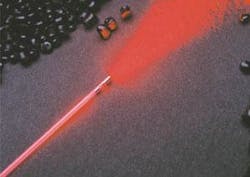In the minimally invasive treatment of photodynamic therapy (PDT), photosensitive drugs first attach themselves preferentially to malignant tumors in the body and then set out to destroy the tumors in response to illumination by specific wavelengths of laser light. Because the drugs are activated only when they have reached the tumors, the procedure minimizes damage to healthy tissue.
PDT faces two problems, however. Its effectiveness depends on the existence of lasers that can deliver light at specific wavelengths appropriate to the drugs. It also requires lasers of high power; power is related directly to dosage of the drug. To overcome those problems, the European Union has created what it calls the “Brighter project.” The goal of the project: creating inexpensive light sources that can deliver powerful beams of various wavelengths of light for medical purposes and other uses. The program, which started in 2006, will then aim to demonstrate the technology in specific applications, such as PDT.
The €16.3 million (US$25.3 million) project, which involves participants from 23 research teams in 11 countries, focuses first on improving laser diodes. These electrically pumped semiconductor lasers have already found broad application in printers, barcode readers, scanners, and other industrial applications. However, says Brighter project coordinator Michel Krakowski of the Alcatel-Thales III-V Lab, “a lot of applications currently are not possible to address without high-powered diode lasers, because of cost, color, or portability. The goal of this project is to develop new lasers with increased power and brightness. It’s about how tightly we can focus the beam.”
Medical uses require laser diodes more precise and powerful than the present generation. “Photosensitizers cannot be activated by light of any wavelength, but only by light within the absorption band of the photosensitizer,” says Tilmann Trebst of biolitec (Jena, Germany), a major participant in the project. “For temoporfin, light at 652 nm is required. Another photosensitizer, ALA, can be activated by light at 633 nm. Sufficient power with the required wavelength is an essential prerequisite for PDT.”
The project has already produced powerful diodes that produce 635 and 650 nm beams of light, and has shown that they are ready for incorporation into a PDT delivery system. Osram Opto Semiconductors is developing the 635 nm diode and Eagleyard Photonics, a spinoff from Berlin’s Ferdinand-Braun-Institut für Höchstfrequenztechnik, produces the 650 nm device. Bernd Sumpf of the Berlin institute outlines the advantages of the latter. “They have high output power, high efficiency, a small vertical far field, and high reliability,” he says. The 650 nm diodes are now being incorporated into medical laser systems built by CeramOptec, a fully owned subsidiary of biolitec. According to Trebst, the first devices based on the new diodes will be available by late 2009 or early 2010.
In a related program, Eric Larkins of the University of Nottingham, Brighter project spokesman, says the researchers are developing frequency-doubled pulsed blue (405 nm) and ultraviolet (340 nm) lasers for fluorescence spectroscopy imaging applications. “These devices complement the PDT application by assisting physicians in locating the extent of the area to be treated,” he says. The blue laser has already been incorporated into a fluorescence imaging system that is undergoing initial clinical tests at Sweden’s Lund Laser Center. The prospects for PDT look brighter already.
About the Author
Peter Gwynne
Freelance writer
Peter Gwynne is a freelance writer based in Massachusetts; e-mail: [email protected].
